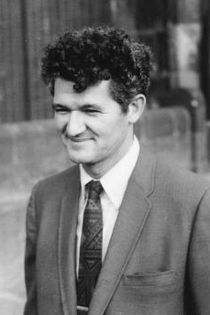Peter Lax facts for kids
Quick facts for kids
Peter Lax
|
|
|---|---|

Lax in 1969
|
|
| Born |
Péter Dávid Lax
1 May 1926 |
| Died | 16 May 2025 (aged 99) New York City, U.S.
|
| Nationality |
|
| Alma mater | |
| Known for |
|
| Awards |
|
| Scientific career | |
| Fields | Mathematics |
| Institutions | Courant Institute |
| Thesis | Nonlinear System of Hyperbolic Partial Differential Equations in Two Independent Variables (1949) |
| Doctoral advisor | K. O. Friedrichs |
| Doctoral students |
|
Peter David Lax (May 1, 1926 – May 16, 2025) was a famous mathematician. He was born in Hungary and later became an American citizen. He won the Abel Prize, which is like the Nobel Prize for mathematics.
Lax made big discoveries in many areas of math. These included how fluids move, how shock waves behave, and how to use computers to solve math problems. He also worked on a special math idea called "integrable systems." In 1958, he made a guess about math problems involving matrices. This guess, called the "Lax conjecture," was finally proven true in 2003.
Contents
Life and Early Education
Peter Lax was born in Budapest, Hungary, on May 1, 1926. His family was Jewish. When he was 12, he became very interested in mathematics. His parents, who were both doctors, hired a math tutor for him. His uncle was also a mathematician.
In 1941, when Peter was 15, his family left Hungary. They traveled to the United States. In high school, Peter didn't take math classes but was on the school's math team. During this time, he met famous scientists like John von Neumann and Albert Einstein.
College and Military Service
Because he was still 17 when he finished high school, Peter didn't have to join the military right away. He studied at New York University for three semesters. He even ended up teaching a complex math class there. In this class, he met Anneli Cahn, who later became his wife.
Before he could finish college, Peter was drafted into the U.S. Army. The Army sent him to Texas A&M University for more studies. Then, he worked at the Manhattan Project in Los Alamos, New Mexico. This was a secret project to develop the atomic bomb. Peter started as a calculator operator but soon moved to more advanced math work.
After World War II ended, he stayed with the Army for another year. He took classes at the University of New Mexico. Then he studied at Stanford University for a semester.
Return to NYU and Later Work
Peter Lax returned to New York University in 1946. He combined his credits from four different universities and graduated that year. He continued his studies at NYU, marrying Anneli in 1948. In 1949, he earned his PhD in mathematics.
In 1954, Peter and his colleagues at NYU used an early supercomputer. They calculated the risk of flooding for a nuclear reactor if a nearby dam was damaged. They found that the reactor would be safe.
Peter Lax made important discoveries about hyperbolic partial differential equations. These are types of math problems that help us understand things like shock waves from explosions, how to predict weather, and how to design airplanes.
He also developed ideas like the Lax equivalence principle. This helps us know when computer math models will give reliable answers. Another idea, called Lax pairs, helps explain how special waves called solitons move. With another mathematician, Ralph Phillips, Lax developed a theory about how waves move around obstacles. This theory is useful for things like radar signals.
Peter Lax was a professor at the Courant Institute of Mathematical Sciences at New York University. From 1963, he was in charge of the institute's computer facilities. He passed away on May 16, 2025, at the age of 99.
Awards and Honors
Peter Lax received many important awards for his work. He was a member of several top science groups, including the National Academy of Sciences, USA.
Some of his major awards include:
- The Lester R. Ford Award (1966 and 1973)
- The Chauvenet Prize (1974)
- The National Medal of Science (1986)
- The Wolf Prize (1987)
- The Abel Prize (2005)
- The Lomonosov Gold Medal (2013)
He was also chosen to give the Gibbs Lecture for the American Mathematical Society in 2007. In 2012, he became a fellow of the American Mathematical Society.
The CDC 6600 Incident
In 1970, a group of students protested the Vietnam War at NYU's Courant Institute. They took control of a large computer called the CDC 6600. Peter Lax had helped get this computer for the institute. The students demanded money to help someone from the Black Panthers. Some students tried to damage the computer, but Peter Lax and his colleagues managed to stop them and save the machine.
See also
 In Spanish: Peter Lax para niños
In Spanish: Peter Lax para niños
- The Martians (scientists)

